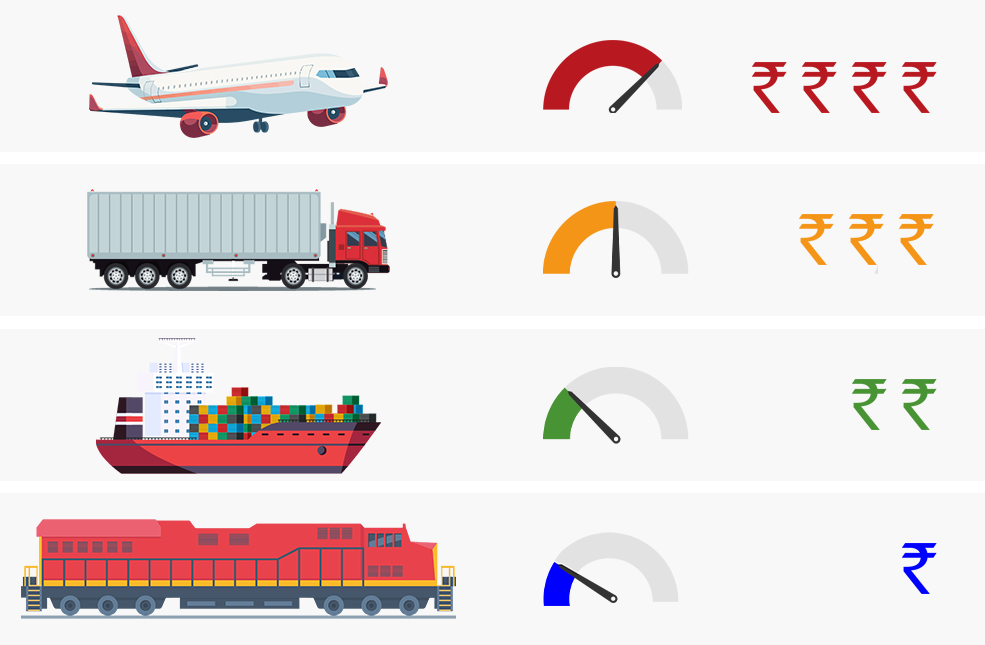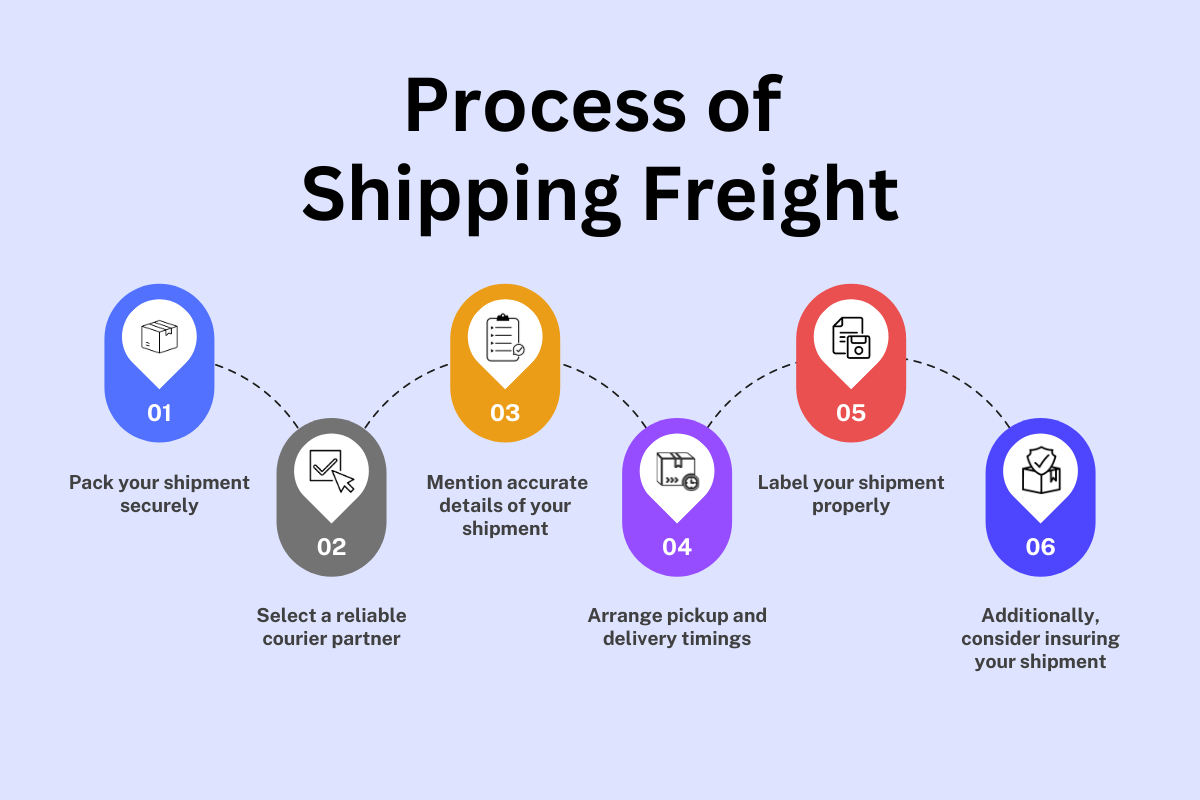What is freight shipping and how can it benefit your business?

Contents:
1. What is a Freight?
2. Introduction to freight shipping
3. Advantages of Freight Shipping
4. Modes of Freight Shipping
5. What are the Factors Determining Freight Shipping Rates?
6. How You Can Ship Freight?
7. How to Find Out Freight Shipping Costs?
8. How to select a freight shipping company
9. How Does Bigship Help in Managing Freight?
10. Documents Needed for Freight Shipping
11. Bodies Involved in Freight Shipping
12. Key Takeaways
Freight shipping stands as the backbone of global commerce. It facilitates the movement of goods across vast distances and diverse terrains. Understanding its intricacies is essential for businesses seeking to optimize their logistical operations and drive growth.
Essentially, freight shipping involves bulk shipping of goods by employing various modes such as trucks, trains, ships, and planes. Its benefits are multifaceted, ranging from enhanced efficiency to expanded market reach and reduced costs.
Exploring the modes of freight shipping reveals a plethora of options tailored to different needs and priorities, from road transport to air cargo. However, comprehending the factors influencing freight shipping rates is crucial, encompassing variables like distance, weight, dimensions, and urgency.
In this blog, we will discuss the intricacies of freight shipping, exploring its benefits, modes, shipping processes, and how to select the ideal freight shipping company for your business needs.
What is a Freight?
Freight refers to goods transported in bulk by land, sea, or air. Items qualifying as freight often weigh over 150 pounds, exceed 108 inches in length or measure more than 160 inches in length plus girth. Freight includes a wide range of goods, from large single items like furniture, cars, and construction supplies to smaller items consolidated on a pallet.

Some freight shipping methods are affordable but slower,while others are faster but pricier. Businesses must consider the cost-benefit ratio of each.
Introduction to freight shipping
Freight shipping simply means the movement of heavy commodities and goods via land, sea, or air. It involves various modes such as truckload, less than truckload (LTL), and intermodal transport. Goods are conveyed by trucks, trains, ships, or planes, facilitating trade and commerce globally. Trucks, railroad cars, and large ships carrying containers are commonly associated with freight shipping.
Freight shipping acts as a crucial conduit for businesses, ensuring efficient product transportation and timely deliveries. It facilitates economic activities across diverse industries and geographical regions by reliably moving goods via various transportation modes.
Advantages of Freight Shipping
Freight shipping offers numerous advantages for businesses of all sizes as it simplifies logistics and enhances efficiency. By utilizing the benefits of freight shipping, businesses can organize their operations, reach new markets, and drive growth and profitability.
Some of these benefits are mentioned below:
1. Expanded Reach: One key benefit is its ability to transport large quantities of goods over long distances which enables businesses to reach customers worldwide. This expanded reach opens up new markets and opportunities for growth.
2. Flexible Transportation: Another advantage of freight shipping is the flexibility that it provides in terms of transportation modes. Whether goods need to be shipped by truck, train, ship, or plane, freight shipping offers a range of options to suit different needs and budgets. This flexibility allows businesses to choose the most cost-effective and efficient method for transporting their products.
3. Time-Saving & Cost-Efficient: Freight shipping also helps businesses save time and money by streamlining the transportation process. Instead of having to coordinate multiple shipments using different carriers, businesses can consolidate their shipments into larger loads, reducing transportation costs and minimizing the risk of delays.
4. Security of Goods: Additionally, freight shipping offers greater security for goods in transit. Freight carriers have strict protocols and procedures in place to ensure that shipments are handled safely and securely. This reduces the risk of theft, damage, or loss during transit, giving businesses peace of mind knowing that their products are in good hands.
5. Reliable way of transportation: Freight shipping enables businesses to better manage their inventory levels and supply chains. By having a reliable transportation system in place, businesses can maintain optimal inventory levels, meeting customer demand without excess stock or shortages.
6. Sustainable: Freight shipping can also help businesses reduce their carbon footprint and environmental impact. By consolidating shipments and using more efficient transportation modes, businesses can minimize emissions and reduce fuel consumption, contributing to a greener and more sustainable supply chain.
Modes of Freight Shipping
Freight shipping employs various modes to transport goods efficiently across different locations. Each mode offers distinct advantages suited to specific cargo types and shipping requirements.
LTL: Less Than Truckload shipping is ideal for smaller shipments that don’t require a full truck. It allows multiple shippers to share space on the same truck, reducing costs and optimizing the utilization of space.
FTL: Full Truckload shipping is best for larger shipments that occupy an entire truck. It offers direct delivery with no stops and ensures faster transit times and less handling of goods.
PTL: Partial Truckload shipping falls between LTL and FTL, catering to shipments larger than LTL but smaller than FTL. It provides cost savings compared to FTL while offering faster transit times and less handling than LTL.
Sea Transport: Sea transport, or ocean freight, is crucial for international shipping, especially for bulky or heavy cargo. It’s cost-effective for transporting large quantities over long distances, although transit times can be longer compared to air freight.
Air Freight: Air freight is the fastest mode of shipping, suitable for time-sensitive or perishable goods. Although it’s more expensive than sea or land transport, it offers rapid delivery and efficient handling. It is ideal for urgent shipments.
Rail Freight: Rail freight is a reliable and cost-effective option for long-distance transportation of goods. It’s particularly advantageous for bulky or heavy items, offering competitive rates and eco-friendly transportation.
Intermodal: Intermodal shipping combines multiple modes of transport, such as rail, truck, and sea, to optimize efficiency and reduce costs. It allows seamless transfer of goods between different modes. This mode leverages the strengths of each to deliver cargo quickly and affordably.
Expedited: For urgent parcels, freight shipping in the expedited mode is the best option. It guarantees quick delivery using planes or trucks. However, it comes at a higher cost due to the need for speed.
What are the Factors Determining Freight Shipping Rates?
Freight shipping rates are influenced by various factors that reflect the complexity and logistics of transporting goods.
1. Shipping Method: The chosen shipping method plays a significant role in determining the rate. Different modes, such as truck, rail, sea, or air, vary in cost due to factors like speed, capacity, and infrastructure requirements.
2. Distance Covered: The distance between the origin and destination greatly impacts freight shipping rates. Longer distances generally incur higher costs due to increased fuel consumption, labor, and maintenance expenses. Moreover, factors like accessibility, congestion, and demand for certain routes can also affect pricing.
3. Freight Size & Weight: Another crucial factor influencing freight shipping rates is the size and weight of the cargo. Larger or heavier shipments typically require more resources and may incur additional fees for handling, loading, and unloading. Freight carriers often use standardized measurement units, such as cubic meters or weight classes, to calculate rates based on cargo dimensions and weight.
Furthermore, other factors like shipment urgency, special handling requirements, and fuel surcharges can also influence freight shipping rates.
How You Can Ship Freight?
Shipping freight efficiently requires careful planning and execution. A simplified process of shipping your freight is mentioned below and by following these steps, you can ensure smooth and efficient freight shipping for your business.
- Firstly, package your goods securely to prevent damage during transit.
- Next, choose a reliable freight carrier based on your specific needs and budget.
- Provide accurate information about your shipment’s size, weight, and destination to ensure accurate pricing and timely delivery.
- Coordinate pickup and delivery schedules with the carrier to streamline the process.
- Properly label your shipments with addresses and tracking information for easy identification.
- Additionally, consider purchasing insurance to protect your goods against loss or damage.
Regularly track your shipments to stay updated on their status and address any potential issues promptly.

How to Find Out Freight Shipping Costs?
Freight shipping costs for sellers depend on shipment volume and weight for single shipments. For multiple shipments, factors like packaging and shipping mode are also considered. Rail and sea transport account for container size and FCL/ LCL. Quotes from various Carrier partners and these factors aid in calculating freight shipping costs.
How to select a freight shipping company
Choosing the right freight shipping company for your e-commerce business can be challenging due to the numerous options available. Here are some factors you should consider while selecting a freight shipping company.
Cost: Evaluate the pricing structure of each shipping company to ensure it fits within your budget. Look for any hidden fees or additional charges that might affect the overall cost. Comparing quotes from multiple carriers can help you find the most cost-effective option.
Coverage: Check the geographical coverage of the shipping company. Ensure they can deliver to all your required destinations, whether domestic or international. A shipping company with extensive coverage can better meet your shipping needs.
Transit Time: Understand the expected transit times for your shipments. Choose a shipping company that can deliver within your required timeframe. Some companies offer expedited shipping options for faster delivery, which can be crucial for time-sensitive shipments.
Range of Services: Look for a company that offers a comprehensive range of services, such as warehousing, packaging, and tracking. Additional services like these can provide added convenience and smoothen your logistics process.
Reliability: Assess the reliability of the shipping company by checking reviews, testimonials, and their track record for on-time deliveries and handling of goods. A reliable company will ensure your shipments arrive safely and on schedule while minimizing the risk of delays or damage.
How Does Bigship Help in Managing Freight?
Bigship excels in managing freight by partnering with 19+ reliable courier partners, covering over 29,000 PIN codes in India and internationally shipping to 220+ countries and territories. Bigship specializes in bulk shipments and ensures efficient, cost-effective, and timely delivery of shipments. Leveraging its extensive network and expertise, Bigship provides seamless logistics management for e-commerce businesses.
Documents Needed for Freight Shipping
For freight shipping, you need to confirm details like the origin, destination, contents, weight, and size of your heavy shipment. Below are the essential documents and certificates needed for this process.
- Packing list
- Commercial invoice
- Bill of Lading
- Sea waybill
- Export/Import Customs Declaration
- Air or rail waybill
- Arrival notice
- Importer security filing
- Letter of Credit
- Certificate of Origin (COO)
- Production Certificate
Bodies Involved in Freight Shipping
The shipping process involves participation from a range of government and non-government entities, as well as organizations and individuals. Some of these bodies are mentioned below:
- Shipper/ exporter
- Consignee
- Freight forwarder
- Notify party
- Carrier
- Port agent
- Ministry of Ports, Shipping and Waterways
- Directorate General of Shipping, Mumbai
- Shipping Corporation of India, Mumbai
- Indian Ports Association
- Customs authorities
Key Takeaways
- Freight shipping is the movement of heavy commodities and goods via land, sea, or air.
- Freight can be transported via several modes of transportation, such as truck, air, sea, and rail.
- Freight shipping is the most cost-effective and efficient method of transporting heavy and bulky goods.
- Freight shipping enhances operations and helps in building a successful and organized supply chain for businesses.
Conclusion
Freight shipping plays a vital role in business logistics as it offers benefits like expanded market reach, cost savings, and efficient transportation. By utilizing modes such as LTL, FTL, sea transport, air freight, and intermodal shipping, businesses can tailor their shipping strategies to their needs. Factors like shipping method, distance, freight size, and weight influence shipping rates, emphasizing the importance of careful planning and accurate information. To ship freight effectively, package securely, choose a reliable carrier, provide accurate details, coordinate schedules, label shipments properly, consider insurance, and track shipments regularly. Using freight shipping optimizes operations and contributes to a successful and streamlined supply chain for businesses.
You can enjoy the benefits of freight shipping via Bigship just by signing up here.
Freight Shipping: FAQs
Ques: What is the meaning of freight shipping?
Ans: The movement of heavy goods and commodities through means like road, rail, sea, and air is called freight shipping.
Ques: What is freight vs cargo?
Ans: Freight refers to goods and commodities transported generally in trucks. Whereas, cargo refers to goods transported via sea, air, or mail.
Ques: What are the three types of freight?
Ans: The three types of freight are:
- Truck freight
- Air freight
- Ocean freight
Ques: Why is it called freight?
Ans: The term “freight train” originated in the 1840s. The term “freight” is derived from the word “fraught” in the mid-1500s, which means “to load.” Gradually the term “freight” started signifying the act of carrying or transporting goods.
Ques: Who is the shipper in freight?
Ans: In freight, a shipper is an individual or a company that supplies or receives goods or commodities by sea, land, or air.
Ques: Is freight air or sea?
Ans: A freight can be shipped via both air and sea. The freight shipped via sea is called sea freight, whereas, the freight shipped via air is called air freight.
Ques: What is freight vs courier?
Ans: Freight typically refers to the transportation of large or bulk goods over longer distances, while courier services specialize in smaller, time-sensitive packages delivered locally or regionally.
Ques: What is delivery by ship called?
Ans: Delivery by ship is commonly referred to as “cargo”, “sea freight” or “ocean freight,” involving the transportation of goods via maritime vessels across bodies of water.
Ques: What is a freight truck?
Ans: Freight trucks are heavy-duty trucks that carry goods from suppliers to customers and link various transportation modes like waterways, shipping, air, and rail.
Ques: Is freight part of logistics?
Ans: Yes, freight is a fundamental component of logistics that involves the transportation of goods to fulfill supply chain requirements efficiently.




